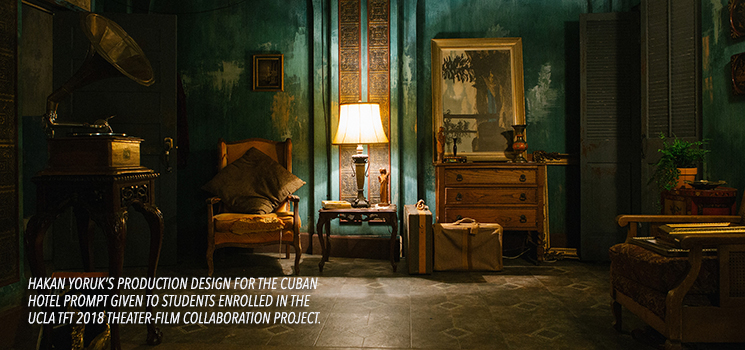News

The Look's the Thing
The talented students in the production design program at UCLA TFT are creating what's next
By Noela Hueso
Four-time ADG Award-winning production designer Mark Worthington (Star Trek: Discovery, American Horror Story, Ugly Betty) gave his M.F.A. students at the UCLA School of Theater, Film and Television (UCLA TFT) a monster of a task in Winter Quarter 2017: To read Mary Shelley’s classic Frankenstein, place the essence of the story in a setting of their choice, according to their own unique vision — and then create that setting on paper in 10 weeks’ time (for some first-year grad students, in just five weeks, as an exercise in quickly bringing ideas to life).
Graduate student Hakan Yoruk, who was a first-year M.F.A. student when he took Worthington’s Frankenstein class recalls, “You’re writing and directing while you’re designing and you have to convince [your fellow students] about your decisions. It’s a tough class.”
Tough but rewarding, Yoruk says. Recent graduates Hogan Lee (M.F.A. ’18) and Irena Jacobs (M.F.A. ’18) agree, as it encouraged them to think creatively and outside the box. The exercise, in Worthington’s Production Design for Film, Television and Video class, is just one example that showcases the exciting work being done in the school’s Design for Theater and Entertainment Media M.F.A. program under the direction of scenic designer and UCLA TFT Department of Theater professor Myung Hee Cho.
Shortly after Cho arrived in 2009 as the head of the school’s respected scenic design program, she began laying the groundwork for the addition of a production design program. While there are other universities that offer both scenic and production design courses, UCLA TFT’s program is the only one in the country that has the two disciplines in the same program.
“I thought it would be a unique opportunity for students here to learn production design, and with the film department as a sister department, it could be our strength,” Cho says.
She scheduled classes, found instructors and, during the university’s subsequent student application period, began accepting individuals into the program who were specifically interested in production design.
“I’m not necessarily looking for a portfolio that looks polished,” she says. “I’m looking for students with ideas, natural talent and enthusiasm for the profession they want to enter. They also need to have good narrative and composition skills, and natural aesthetics. Good taste is very hard to teach.”
By 2012, Cho says, the new program “was fully operating in terms of curriculum.” In 2013, the David C. Copley Center for Costume Design at UCLA TFT secured the first $100,000 from the Cecil B. DeMille Foundation to expand the production design program, which allowed master classes to be conducted by such established industry veterans as Academy Award-nominated production designer Michael Corenblith (Frost/Nixon, Saving Mr. Banks), who returns annually to teach at the school; and this past academic year, Academy Award-winning production designer Rick Heinrichs (Star Wars: The Last Jedi, Sleepy Hollow, A Series of Unfortunate Events, Pirates of the Caribbean: Dead Man’s Chest) was named the Cecil B. DeMille Production Designer in Residence at UCLA TFT. Now, Cho says, the program is hitting its stride in all areas and is particularly proud of the production design faculty she has curated.

“They enjoy and really thrive on students’ work and they invest their time in them,” she insists. “When Mark takes production design jobs out of town, he’ll fly into L.A. on Friday, teach a class and fly out again on Sunday. In Spring Quarter 2018, [Santa Clarita Diet production designer] Kitty Doris-Bates [who also instructs undergraduate students] committed to teaching for us — and then got a job in New Orleans. She commuted on the weekends for almost eight weeks! Our faculty show incredible dedication to our students and their growth and careers afterward.
“Even if they’re not teaching, they’re tracking student progress,” Cho continues. “They come back to critique student work during other instructors’ classes; the feedback students receive is reinforced by not just one faculty member but by a number of them.”
The instructors often work in tandem with each other to help facilitate student work, too.
“Several times, students in [award-winning production designer and art director] Tony Fanning’s (Better Call Saul, The New Normal) production design class have built upon the concept established in Mark’s class, developing the practical aspects of the design and taking it to the next level,” Cho says.
Jacobs, who worked as an architect for two years before changing her path and starting graduate school, says that as a student, she found the program at UCLA TFT to be comprehensive.
“The professors at UCLA TFT are incredible — our classwork was very concept driven but we also had the component of actually working on set, which is a really complete education. This taught us how to think, how to be designers and how to ask the right questions to a team when we’re working on a film with directors and cinematographers.
“We had skills classes such as figure drawing,” she continues, “we had costume design classes; we had amazing digital rendering classes with [ADG Awards nominee] Nathan Schroeder (Pacific Rim Uprising, Kingsman: The Golden Circle, War of the Planet of the Apes). There was a virtual VR class, which was amazing: We got to build models in Maya, and then imported it into a VR program, which was super challenging but really fun.”
Lee says it’s an advantage that the instructors are working professionals in the field, too.
“The industry is changing so fast,” Lee says. “Having working professors is incredibly important; they know what’s going on [in Hollywood] and what skills you need before you graduate and will help you with connections [after graduation.]”

Adds Cho: “We train our students not only as designers but as critical thinkers; when they take on a script, we want them to deliver on a project based on their understanding of the script, the characters and the environment.”
UCLA TFT’s interdisciplinary approach to learning means that students from both the Department of Theater and the Department of Film, Television and Digital Media take classes together. Students in the academic year-long Theater-Film Collaboration Project, comprised of screenwriters, directors, cinematographers, editors, actors, costume designers and production designers, together create a series of short films. Depending on their roles, students participate in different phases of the project. They’re given prompts (a Cuban hotel room in 2018; an auto body shop in 2017) that inspire the scripts written by the screenwriters and the environments created by the unit production designers — a single sets that need to work for each of the four films that will be made. The trick is that each screenplay is a different genre.
“They ask us to design the set in such a way that it can be changed for all four of those shorts [from a single theme],” Jacobs says.
“You learn how to lead a team,” Yoruk says of the experience. “You can be a really good designer on paper or screen but without these kinds of experiences [working with people in various disciplines] or without knowing how to realize your ideas, you’re not as fully equipped to go out into the real world. This class helps a lot.”
The Design for Theater and Entertainment Media program is intentionally small, accepting just three to five students annually, and the job success rate for graduating students stands at 100%. This past academic year, all four third-year production designers were accepted into the prestigious Art Directors Guild Production Apprentice Training Program, which provides mentorship, supervision and on-the-job training to upcoming production designers and art directors. While the school has been placing third-year students with the ADG since they started their programs in 2012, this is the first year that all of the students have been accepted, much to Cho’s delight — though she’s not surprised.
“Their body of work speaks for itself,” she says. “All the third years [were] strong designers. They already have a lot of production experience from their many school projects. They show really well. They’re ready.”
Lee, who arrived at UCLA TFT with more practical, real-world experience under his belt — he worked on Ang Lee’s Life of Pi (2012), Luc Besson’s Lucy (2014) and Martin Scorsese’s Silence (2016), has been placed in the assistant art director track while Jacobs and fellow graduates Tatiana Kulianoff and James Maloof are part of the PA Apprenticeship program. After 260 hours of work tracked by the ADG, they will be eligible for union membership.
“[You have the opportunity to] work with production designers directly; they may let you do some graphics or some drafting, to see what you excel at and what you enjoy,” says Jacobs, who is working on Santa Clarita Diet this summer. “I'm excited to have such great hands-on experience as well as a fast track into the guild.”
Posted: August 24, 2018





